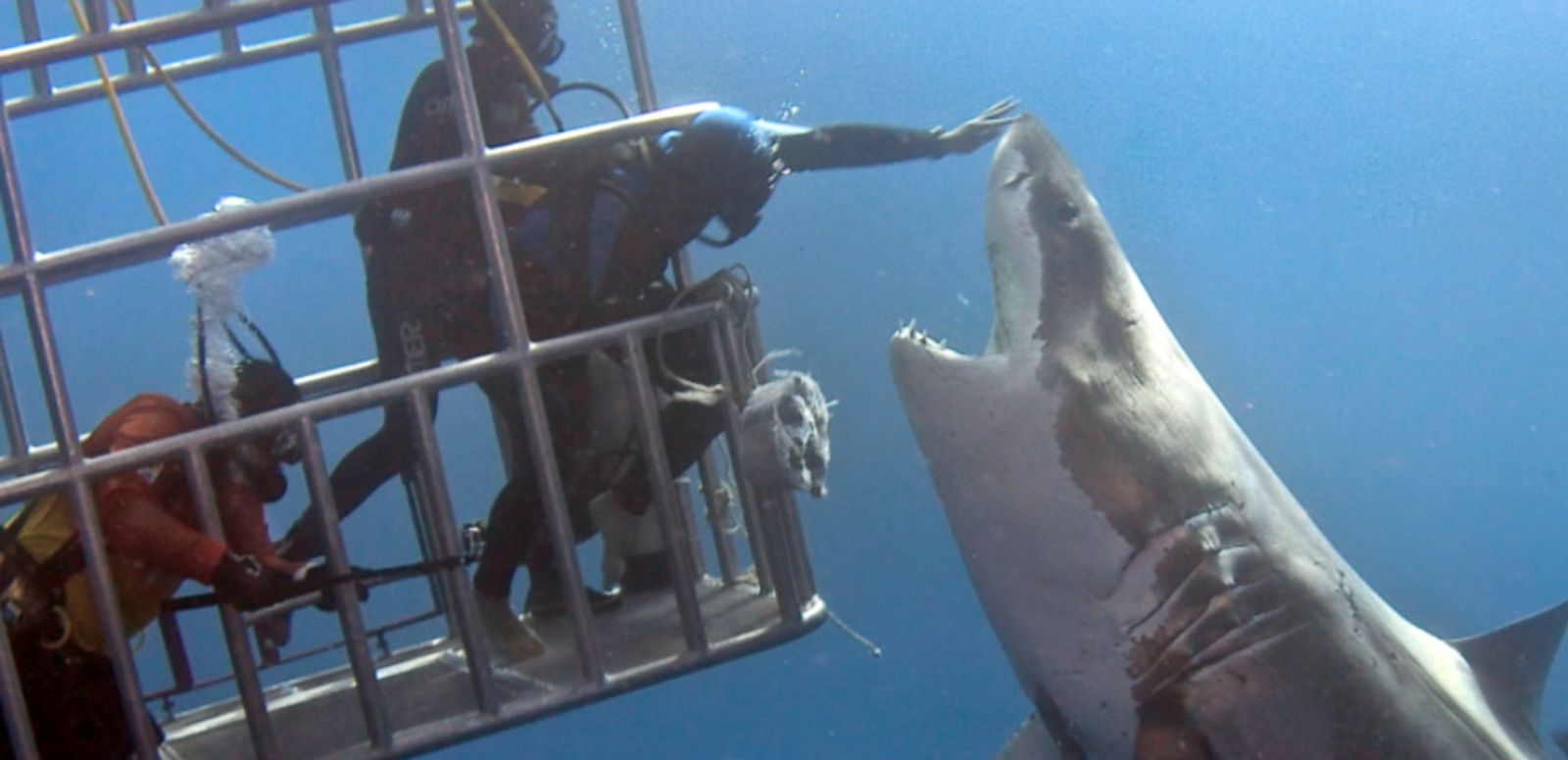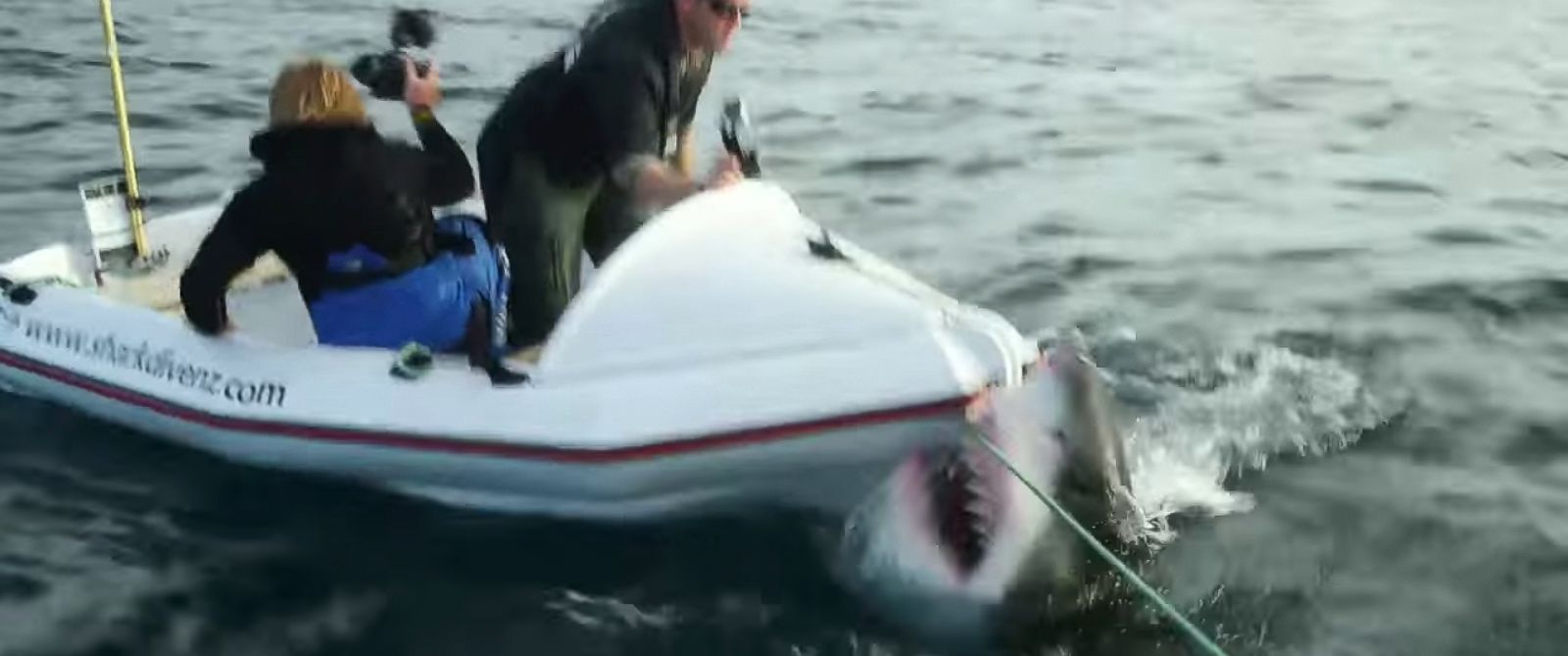Sharkwatching: HighTechly With Drones

Mark Girardeau hovered his drone above the water in Dana Point, Calif., looking for movement.
Then he saw it: A dark figure darting swiftly; a fin piercing the ocean’s surface.
“I got one,” he shouted out as he zoomed in on the great white, swimming just yards from shore. On the sand, other lookie-loos clutched cell phones, trying to capture images of the sharks that have caused such a buzz in recent weeks.
As Girardeau watched, the shark show grew.
“I got two sharks. There’s two great whites right here … There’s actually three now!”
Not too long ago, getting even a glimpse at great white off the Southern California coastline was rare. The occasional lifeguard or surfer might see a fin — or think they did — but they almost never had evidence to back their claim.
Then came two changes. First, in recent years, more sharks have been hanging out close to shore in Southern California. The phenomenon isn’t totally understood and it’s unclear if it’ll last, but it’s been a constant for three years. Second, everybody has access to an explosion of technical advances — everything from drones to GoPros to better video and higher-def resolutions in cellphones — that make it easier to chronicle shark sightings.
That, in turn, has turned shark watching into a pastime. Apart from most surfers — who want to stay as far away as they can — the world seems fascinated to check out sharks near the shore. There’s even a “Shark Tour” available from boats in Dana Point, Calif.
“Thirty years ago, I thought, ‘a lot of people in Southern California might go their entire lives and never get an opportunity to see a shark in the wild,’ ” said Chris Lowe, a great white expert who leads the Shark Lab research project out of Cal State Long Beach.
That’s no longer true, Lowe said.
“In some cases, they are going to see a shark, and that will be one of the coolest things they’ll see in their life.”
Lowe said it’s more than just “they’ve always been there, we can just see them because of technology.” Fisherman, lifeguards, and longtime pilots have never seen as many sharks off the Southern California coast as they have recently.
Some encounters are a little too close to comfort. Last month, a woman nearly died after she was bitten by a shark while surfing at Church beach near San Onofre. A year ago, another woman nearly died after being bitten by a shark while she trained for a Triathlon by swimming off the shore in Corona del Mar. Those were the first two major shark attacks on record in Orange County, and part of a broader pattern of close encounters.
In recent months, sharks have even photo bombed surfers, sometimes without the human knowing what happened until they’d seen the footage.
That’s what happened to surfer David Woodward, who paddled out early March for a session at San Onofre State Beach. After owning his GoPro for five years, he decided to put it on his board to try it out.
“While sitting on my board in the takeoff zone, I saw a shark in the next wave. He was about ten-feet away, out in front of the left side of my board, about to swim past me,” he wrote in an email.
It was the fifth juvenile great white he’d seen in the area at Trails, a known nursery for great whites. Initially, he wasn’t too concerned.
Then the creature took a sudden 90-degree turn — in Woodward’s direction — and that got his attention.
“That’s all I saw because, at that point, I swing my board around and tried to catch that wave to get the heck out of there.”
When he got home, he looked at his footage: Behind him, the shark was in the cresting wave, just behind him.
Surf cameras dotting the coastline by Surfline.com have also captured some interesting action. There was a breaching shark at Lower Trestles near surfers, just weeks before the April 29 attack at nearby Church beach. That video went viral after it was posted on social media.
Dave Gilovich, director of editorial for Surfline.com, saw first-hand how the “cam rewind” technology works. After sitting in the line up at Uppers at San Onofre State Park, a shark breached near him.
“I was the only one who saw it,” he said, “but it was clear as day.”
He checked the time with a guy on the sand, made a mental note, then, later, hit the “cam rewind” on the camera directed at Uppers surf break.
“I waited and waited. And, all of a sudden — boom! — there it was.”
Then there was a chilling video at the same spot the morning after the April 29 attack, as three guys suddenly started paddling for shore.
“You could see all three of them turn immediately and paddle right back onto the rocks,” Gilovich said.
One of the surfers emailed him, asking if they had the footage of a fin that came 6-feet behind them, spooking them toward shore.
“We already posted that clip, here’s the YouTube link,” Gilovich responded.
He said the footage helps add to the awareness of the suddenly shark-infested situation in Southern California water.
“The new technology is educating us about what’s out there now,” Gilovich said.
On Wednesday, Dana Wharf Whale Watching captain Frank Brennan flew a drone over a group of sharks at Capistrano Beach, practice for a “Shark Tour” his charter company plans to hold on Saturday. The captain, with 30 years of experience in the ocean, said the shark sightings are unprecedented.
“It’s super new. Every once in a while, you might see one as you’re driving along, kind of random,” he said. “I’ve never seen anything like this, this many sharks.”
One five-footer even came close to check out his boat. He hopes he’s able to replicate the experience during the shark tour. They held a few last year when there was word of hammerheads in the area, but he thinks this time it’s going to give a whole new experience to spectators.
“A lot of people have been fascinated by sharks their whole life,” he said. “(Before), you’d have to go to Guatalupe Island or something and get in a cage. I know a lot of people are excited about it.”
Last week, two tow-boat drivers used GoPros to capture a cluster of sharks hanging around shore in Long Beach.
Ricky Birks, a 26-year-old from Huntington Beach, Calif., estimates that he saw 13 sharks, some as close as 50 feet from the beach.
“If you walk into the water, you’re ankle deep and you’re right next to them,” he said.
He noted that the great whites seemed to like the sound of the motor, and came to the boat and checked them out. The creatures also approached the GoPro the men had slipped into the water to capture shark close-ups. Several sharks swam over to it.
“It’s nothing like I’ve ever seen before. I spearfish and dive and scuba dive. I’ve seen sharks before, but not great whites,” said Birks.
“Seeing a great white that close up, it’s kind of scary.”
The sharks weren’t aggressive, and several people riding stand-up paddleboards slipped through the group without incident. He said about 6 or 7 of the sharks jumped out of the water.
“It’s a little eerie,” he said. “They’re just cruising around, feeding in the shallows.
“Hopefully, they can get what they need to get done and they can move on to the next spot,” he added.
Birks is working with Lowe’s Shark Lab to help document the animals. Lowe said the footage his team gets from GoPros is great, not just for the public, but also for scientific advances.
“They are the only thing we can afford, and they are good science tools,” he said of the images. “We can identify individuals, and count individuals, and measure how big they are.
“It’s a game-changer for science.”
Still, Lowe worries about the public getting too close to sharks. His team, he noted, has completed extensive training on how to behave near sharks.
“A lot of the times the public isn’t properly trained, that’s when people get injured,” Lowe said. “It’s cool to say you’ve seen a great white shark. But chasing them around isn’t a good idea.
“Because if they do feel threatened, they will defend themselves, like any wild animal.”
He said to remember that we are visitors. In the oceans, sharks are the locals.
“We have to respect their home,” Lowe said.
“If someone busted in your home to take pictures of you, chances are you’d be chapped.”






